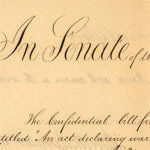#57: CIVICS 101: The Legislative Branch
Q&A #57: What is the procedure to commit the country’s military force to war?
Our American Government
Our American Government is a small book published by the House of Representatives for citizens and those who seek a greater understanding of the American interpretation of democracy. It follows a question-and-answer format and covers a broad range of topics dealing with the three branches of our Government, the electoral process, and the role of political parties.
The Savvy Citizen is reproducing the 169 questions-and-answers through a series of posts called Civics 101. Each post will contain the Q&A as well as some additional commentary to add historical context, fun facts, or anything we believe will add to our collective understanding of these topics.
Think of it as your adult Civics class but without the test!
Let’s keep at it.
SECTION: The Legislative Branch: The Congress
Congressional Process and Powers
Q&A #57: What is the procedure to commit the country’s military force to war?
The Constitution gives to Congress the authority to declare war; this has occurred on only five occasions since 1789, the most recent being World War II.
But the President, as Commander in Chief, has implied powers to commit the Nation’s military forces, which has occurred on more than 200 occasions in U.S. history. Moreover, Congress may authorize the use of the military in specific cases through public law.
The War Powers Resolution, enacted on November 7, 1973, as Public Law 93–148, also tried to clarify these respective roles of the President and Congress in cases involving the use of armed forces without a declaration of war.
The President is expected to consult with Congress before using the armed forces ‘‘in every possible instance,’’ and is required to report to Congress within 48 hours of introducing troops.
Use of the armed forces is to be terminated within 60 days, with a possible 30–day extension by the President, unless Congress acts during that time to declare war, enacts a specific authorization for use of the armed forces, extends the 60–90 day period, or is physically unable to meet as a result of an attack on the United States.
My Thoughts
As noted above, the Constitution grants Congress the sole power to declare war.
Congress has declared war on 11 occasions [covering five (5) conflicts], including its first declaration of war with Great Britain in 1812. Congress approved its last formal declaration of war during World War II.
Since that time it has agreed to resolutions authorizing the use of military force and continues to shape U.S. military policy through appropriations and oversight. {Vietnam was one such conflict given that Congress never issued a formal declaration of war].
The Mexican War (May 12, 1846)
The Spanish-American War (April 25, 1898)
World War I
There were technically two (2) specific declarations of war in World War I:
World War II:
There were technically six (6) specific declarations of war in World War I
—
Back next time with a new section—Congressional Rules and Procedures- and a new Q&A #58: How are the rules of procedure in Congress determined?
Meanwhile, don’t forget that we’re organizing the post links on a single page available here.
xo,
Kelley for the Savvy Citizen Team
March 4, 2025





